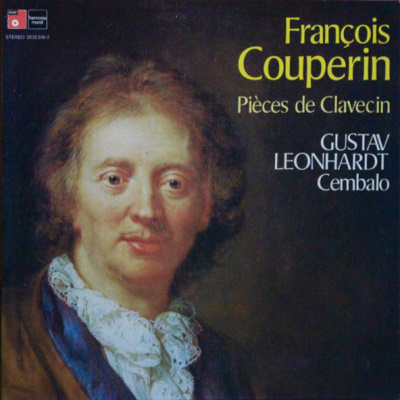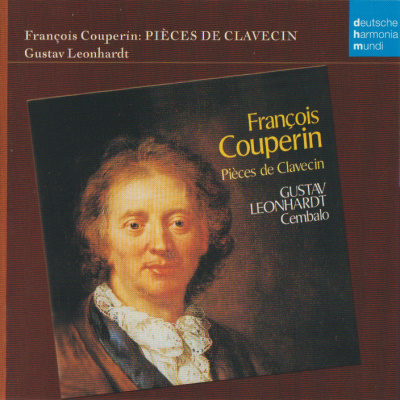 |
|
1 LP -
20 20348-2 - (p) 1971
|
 |
| 1 CD -
82876 70000 2 - (c) 2005 |
|
PIÈCES DE
CLAVECIN
|
|
|
|
|
|
|
|
|
| Frabçois COUPERIN (1668-1733) |
Prélude Nr. 3 in g - aus "L'art
de toucher le clavecin", 1716 |
|
|
1' 01" |
A1 |
|
Septiême Ordre - aus "Pièces
de clavecin" II, 1717
|
|
|
11' 43" |
|
|
-
La Ménetou. Rondeau
|
|
2' 38" |
|
A2 |
|
- Les Petits Ages
(La Muse Naissante | L'Enfantine |
L'Adolescnte. Rondeau | Les
Délices. Rondeau)
|
|
10' 42" |
|
A3
|
|
|
a) La Muse
Naissante |
2' 01" |
|
|
|
|
|
b) L'Enfantine |
1' 28" |
|
|
|
|
|
c) L'Adolescnte.
Rondeau |
3' 43" |
|
|
|
|
|
d) Les Délices.
Rondeau) |
3' 30" |
|
|
|
|
-
La Basque
|
|
2' 40" |
|
A4 |
|
- Les Amusemens
|
|
3' 59" |
|
A5 |
|
Prélude Nr. 5 in a - aus "L'art
de toucher le clavecin", 1716 |
|
|
2' 43" |
B1 |
|
Cinquiême Ordre - aus
"Pièces de clavecin" I, 1713 |
|
|
20' 49" |
|
|
- Allemande. La Logivière |
|
4' 58" |
|
B2
|
|
-
Courante - seconde Courante
|
|
4' 35" |
|
B3 |
|
-
Sarabande la Dangereuse
|
|
2' 12" |
|
B4 |
|
-
Gigue |
|
2' 16" |
|
B5 |
|
-
La Flore
|
|
2' 37" |
|
B6 |
|
-
Les Agrémens. Première et seconde
partie
|
|
4' 11" |
|
B7 |
|
|
|
|
|
|
Gustav Leonhardt,
Harpsichord (Martin Skowroneck, 1962,
nach J. D. Dulcken, 1745)
|
|
|
|
|
|
Luogo
e data di registrazione |
|
Amsterdam (Holland) -
1971 |
|
|
Registrazione: live
/ studio |
|
studio |
|
|
Recording
Supervision |
|
Dr. Thomas Gallia |
Dr. Alfred Krings
|
|
|
Engineer |
|
Sonart |
|
|
Prima Edizione LP |
|
Harmonia Mundi (Basf)
| 20 20348-2 | 1 LP - durata 44'
40" | (p) 1971
|
|
|
Edizione CD |
|
Deutsche Harmonia
Mundi | LC 00761 | 82876 70000 2 |
1 CD - durata 44' 40" | (c) 2005 |
ADD
|
|
|
Cover Art
|
|
-
|
|
|
Note |
|
-
|
|
|
|
|
"...
j'avoueray de bonne
foy que j'ayme
beaucoup mieux ce qui
me touche que ce qui
me surprend."
from
the forward to the Pièces
de clavecin I
A French composer who writes
no ballets is like an
Italian composer who has no
interest for the opera. None
of the works of François
Couperin was intended for
the stage; nothing was
written for orchestra-and
yet his contemporaries
admired him as organist,
harpsichordist, composer and
teacher. Descendents term
his contribution the "sum of
French music".
The respected office of
organist at St. Gervais was
reserved as early as 1679
for the eleven-year-old upon
the death of his father
Charles. His uncle Louis
Couperin had already been
active at this church; the
nephew assumed (entered upon
the office at seventeen).
Five years later he
published his two masses for
organ, which established the
fame of the composer. Upon
taking the position as
organist at the Chapelle du
roy in Versailles in 1693,
he attained the external
peak of his career. Spending
his entire life in Paris, he
was to become not only
teacher to the royal family,
but also mentor to a
generation of French
musicians. The fruits of
Couperin's pedagogic
engagement were made
manifest in 1716 with the
publication of the Art
de toucher le clavecin,
which he dedicated to the
young Louis XV. Bach used
this theoretical work, the
knowledge of which is the
foundation of the study and
performance of French music
for harpsichord, without
which, however, the
interpretation of German
music in the French style
must remain inadequate.
The life of the organist and
harpsichordist at Versailles
passed without crucial
turning points. Similar to
Bach, Couperin concentrated
during the last twenty years
of his life on the
collection and accurate
editing of his works. His
work is easily surveyable.
Several motets along with
some “versets", a few
elevations, and above all
the late, very expressive Lamentations
of Jeremias comprise
the entire extant body of
sacred music. The chamber
music consists mainly trios,
the older of which being in
the Italian style of sonatas
for 2 violins and basso
continuo.The younger vary in
orchestration and attempt in
their language to combine
Italian and French styles.
The title of a collection
from 1724 is typical: Les
Goûts réunis. Also in
the field of chamber music a
late work comes to represent
a culmination; the Pièces
de viole (1728),
written for the less and
less used viola da gamba.
Even during Couperin’s
lifetime, the Pièces de
clavecin enjoyed a
wide popularity. The
“ordres" of the published
pieces in four books
correspond only remotely to
the stricter forms of the
suites as they were composed
in Germany. They are for the
most part collected works
which were preferred in
earlier periods and from
which the performer might
chose. Although Couperin
used in the fifth ordre the
traditional plan with the
series Allemande, Courante,
Sarabande and Gigue, the
movements are nevertheless
often individual portraits
rather than parts of a
larger context. In the
seventh ordre the poetic
pictures are ordered
entirely one after the
other, possessing little
suggestive painting and
having usually short and
clear musical forms,
dance-like, with a floating
lightness even where the
dark registers of the
harpsichord are preferred.
In each of these movements
Couperin has, as he wrote,
an "objet" which he
continually repeated or
transformed. Thus the
metamorphoses of a musical
idea can be found in the
numerous Rondeaux, as well
as in the forms of the
Chaconne.They reflect
ideally the wish for a
"unité de sentiment" of the
French art.
The elegance of all these Pièces
recall the model of the
seventeenth-century French
lutenists who influenced so
permanently the harpsichord
style. The tendency to
arpeggi and free passages
becomes especially evident
in those seemingly
improvised Préludes
of the Art de toucher,
which Couperin intended as
introduction for his
"ordres”. Even his
contemporaries recognized
that Couperin was the
counterpart to a cold
virtuoso, as he appears
sometimes in
interpretations. The author
of a work which mirrors the
brilliant superfluousness of
French art and nonetheless
is capable of producing
deeply expressive sounds
speaks about this himself: "...
I confess in all
seriousness that I love
rnuch more that which
moves me than that which
surprises me".
|
  |
|
|